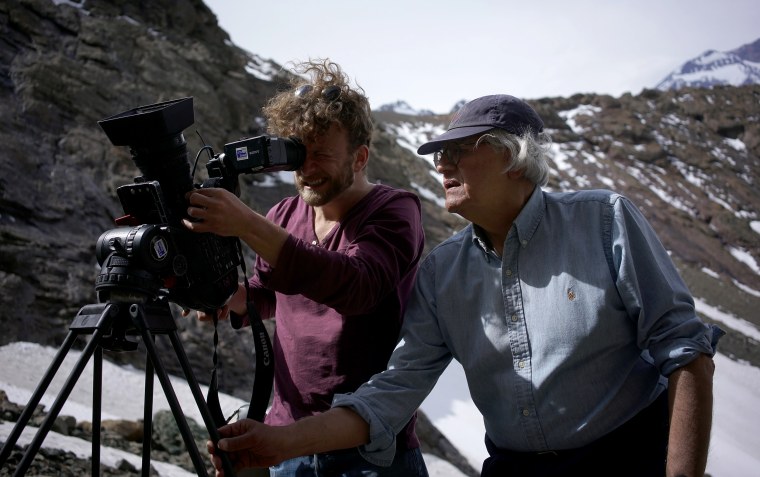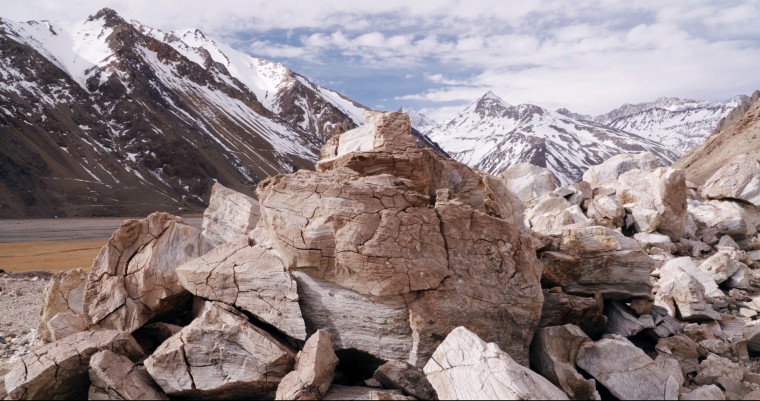Can one of the world's grandest mountain ranges also hold the memories of a country, including wrenching brutality and loss?
Acclaimed Chilean filmmaker Patricio Guzmán takes on the world’s longest cordillera, or mountain range — specifically the high Andes peaks that delineate the Chile-Argentina border — in a new documentary about the victims of the late Augusto Pinochet’s brutal dictatorship, as well as the ongoing protests that are shaking Chile today.
“If the rocks of the cordillera could speak, they would speak of the blood that ran over them,” the award-winning Chilean documentarian says in a voiceover during his new movie “The Cordillera of Dreams,” which won the 2019 best documentary prize at the Cannes Film Festival and will kick off a national release in the United States after premiering Wednesday at the IFC Center in New York.
The filmmaker refers to the paver stones on the streets of the country's capital, Santiago, which are cut from the mountain range. Viewers will see close-ups of plaques inserted in between these stones with the names of Pinochet’s victims engraved on them. More than 40,000 people were victims of human rights violations including torture from the regime, with more than 3,000 reported missing.
The Andes are often described as a reptile-like backbone that cut over 5,000 miles through seven South American countries — Venezuela, Colombia, Ecuador, Perú, Bolivia, Chile and Argentina. This has both protected and isolated Chile from the rest of the world, says Guzmán.
“The cordillera is a wall, a natural border that surrounds Chile entirely. Beyond it is the world. And just 100 kilometers west from the mountain range is the infinite ocean,” he told NBC News in a phone interview. “So Chile has been created, born and developed differently from other countries in this narrow corridor. There is something very specific about the cordillera, the closure, the restricted language, the silence, and the inward mentality, that makes Chile different from other places.”

Memory and loss are common themes in Guzmán’s documentaries. The filmmaker is most famous for his three-part “Battle of Chile,” which chronicles the political tensions and the violent military coup that overthrew Chile's democratically elected socialist president Salvador Allende in 1973.
The acclaimed series has become a must-see classic for many students of Latin American history. Guzmán continues to explore those themes in “The Cordillera of Dreams,” documenting how the past still lives in the present and influences younger generations today.
He said the violent 1973 coup caused "mass disorientation" in the people who lived it, and produced a huge void in the country. Forty years later, "people are taking to the streets to sing hymns from the left that are over four decades old. It’s like the country is waking up from a very long dream,” Guzmán said.
“The Cordillera of Dreams” points out how Pinochet’s regime adopted an economic model derived from the "Chicago School" free-market theories of the American economist and 1976 Nobel laureate Milton Friedman. At present, the country is being rocked by protests over what many see as mass inequalities and steep costs for those at the lower rungs of the economic ladder.
Guzmán says the majority of Chileans supported Allende’s progressive values. The filmmaker uses the Andes to represent that neglected majority.
During a moment of introspection in the film, the Chilean sculptor Francisco Gazitúa reflects on how the mountains represent 80 percent of Chile’s territory, and how Chileans have an obligation to take care of it.
“A country that leaves 80 percent of its territory abandoned is not viable,” the sculptor says on camera. “This country must take care of its cordillera. It must take care of 80 percent of itself.”
As for Guzmán, while geography can be a natural barrier between countries and cultures, the Andes can also be a gateway that calls on the viewer to explore what lies behind it.
“The cordillera is like all other mountains in the world. There are many different secrets hidden inside of it,” he said. “But while it has a geographic element, it also has a deeper spiritual element that can transform the mountains into a metaphor, a door or gateway into the dreams, history, food and culture of Chile and other countries today.”
Follow NBC Latino on Facebook, Twitter and Instagram.
